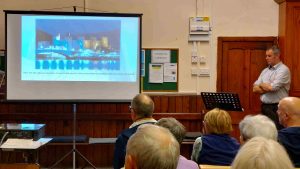Conwy’s Military History
On 20th October 2022 the History of Deganwy Group were pleased to welcome Adrian Hughes to present a talk titled “Conwy’s Military History”. Adrian has presented to our group on several occasions and we were not disappointed to listen to Adrian’s latest research which we understand will be available in a book in the near future.
The area around Deganwy and Conwy is littered with evidence of conflict between various groups throughout the ages, if you know how to interpret the findings. Probably the earliest evidence is from the Iron Age fort of Caer Seion on top of Conwy Mountain. The construction of the original fort is still unknown, but excavations have revealed evidence of occupation as early as 6th century BC.

Nearer to “home” is our very own Deganwy Castle, which has been the subject of talks to our group in recent years. Over centuries, several constructions have been built on the site, initially just wooden ramparts and ditches (10th century) to more substantial stone walls and towers (13th century) by Prince of Wales Llywelyn ab Iorwerth. Due to its position, the Vardre has been occupied since Roman times, through Maelgwn Gwynedd and the Princes of Gwynedd. Much of the stonework that remains today is either from the time of Llywelyn’s rebuilding of 1213 while the round tower is from the time of Henry III.
Between 1283 and 1330 King Edward 1 constructed a chain of castles at Rhuddlan, Conwy, Caernarfon and Beaumaris as part of the subjugation of the Welsh. Deganwy castle was left in ruins and some of the stonework was probably used in the construction of Conwy castle and town walls across the estuary.
During the Civil War, 1642 to 1651, Conwy was again involved, being besieged and bombarded by cannon located near Gyffin.. This was the subject of a previous talk by Dennis Roberts on 20th July 2017 (see Talks Archive for details).
Conwy Morfa was the setting for annual summer training camps for the Territorial Army for the latter half of the 19th century. During the First World War several regiments were trained here on the firing ranges and carried out physical exercises on Conwy Mountain and the nearby Great Orme.
Later, during the Second World War workers were billeted in the area to work on the secret construction of the prototype Mulberry Harbour. When completed this enabled the Allies to create a “port” in Normandy to facilitate the rapid offloading of troops, armour and supplies when existing French ports had been destroyed by the German defenders. Several of the Mulberry Harbour Caissons still exist today in Normandy.

The residents of Deganwy and Conwy have a proud association with the various military organisations, many having served in the armed forces at some time in their lives. We are grateful to Adrian for his work in this area and for reminding us of the commitment shown by locals during times of conflict, when they are serving their country. We wish him well in the release of his new book which will include more details of Conwy’s Military History.
Latest Research